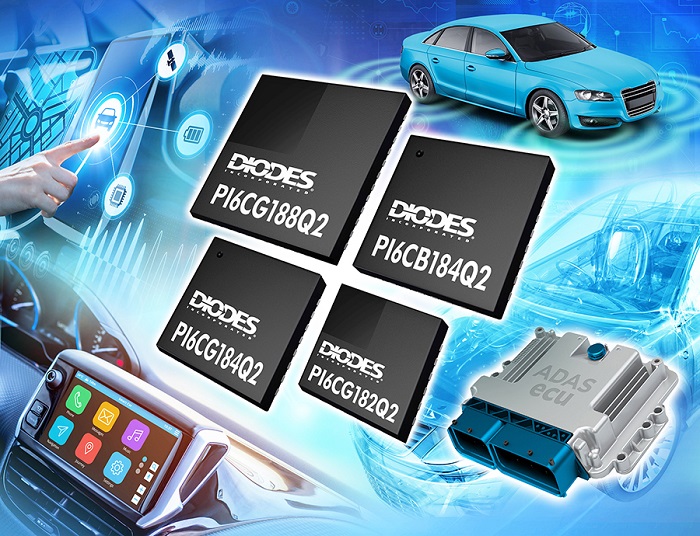By Gina Roos, editor-in-chief
Diodes Inc. released a family of automotive-compliant PCI Express (PCIe) 4.0 clock generators and buffers for automotive applications, including head units, electronic control units (ECUs), advanced driver-assistance systems (ADAS), navigation, telematics, and infotainment. These new clocks generate a reference clock signal for chipsets using PCIe Gen 4 interfaces.
The PI6CG182Q, PI6CG184Q, PI6CG188Q (PCIe 4.0 clock generators), and PI6CB184Q (PCIe 4.0 clock buffers) provide differential low-power, high-speed current steering logic (HCSL) outputs with on-chip termination. They are all qualified to AEC-Q100 Grade 2, with an operating temperature range of −40°C to 105°C, and feature wettable-flank QFN packages to ensure compatibility with automated visual inspection.

Here are the parts:
- The PI6CG182Q (clock generator, two outputs) is available in the 26-TQFN package (4 × 4 mm) and is priced at $1.35 each in 3,000-piece quantities.
- The PI6CG184Q (clock generator, four outputs) is available in the 32-TQFN package (5 × 5 mm) and is priced at $1.50 each in 3,000-piece quantities.
- The PI6CG188Q (clock generator, eight outputs) is available in the 48-TQFN package (4 × 4 mm) and is priced at $1.80 each in 3,000-piece quantities.
- The PI6CB184Q (clock buffer, four outputs) is available in the 32-TQFN package (5 × 5 mm) and is priced at $1.42 each in 3,000-piece quantities.
The devices leverage Diodes’s proprietary PLL technology and include advanced features such as programmable output slew rate and amplitude and selectable spread-spectrum on differential outputs to help minimize EMI — a benefit particularly when designing for an automotive environment.
Thanks to an operating voltage of 1.8 V and integrated on-chip termination for every HCSL output, the devices minimize power consumption and eliminate the need for external resistors. Diodes said that designers would typically need to add four resistors per output pair or up to 32 resistors for an 8-output device, losing power via the external resistors. In addition, each output features its own enable pin for additional power management improvements on unused outputs.
Advertisement
Learn more about Electronic Products Magazine





